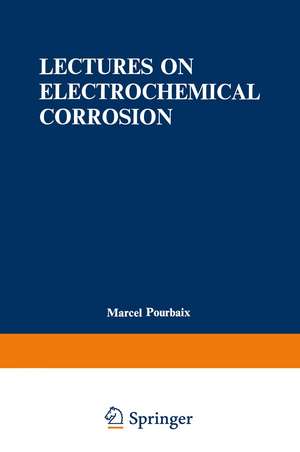Lectures on Electrochemical Corrosion
Autor Marcel Pourbaixen Limba Engleză Paperback – 19 mar 2012
Preț: 948.53 lei
Preț vechi: 1156.74 lei
-18% Nou
Puncte Express: 1423
Preț estimativ în valută:
181.51€ • 194.09$ • 151.33£
181.51€ • 194.09$ • 151.33£
Carte tipărită la comandă
Livrare economică 18 aprilie-02 mai
Preluare comenzi: 021 569.72.76
Specificații
ISBN-13: 9781468418088
ISBN-10: 1468418084
Pagini: 364
Ilustrații: XXII, 336 p.
Dimensiuni: 152 x 229 x 19 mm
Greutate: 0.53 kg
Ediția:Softcover reprint of the original 1st ed. 1973
Editura: Springer Us
Colecția Springer
Locul publicării:New York, NY, United States
ISBN-10: 1468418084
Pagini: 364
Ilustrații: XXII, 336 p.
Dimensiuni: 152 x 229 x 19 mm
Greutate: 0.53 kg
Ediția:Softcover reprint of the original 1st ed. 1973
Editura: Springer Us
Colecția Springer
Locul publicării:New York, NY, United States
Public țintă
ResearchDescriere
Workers in the field of corrosion and their students are most fortunate that a happy set of circumstances brought Dr. Marcel Pourbaix into their field in 1949. First, he was invited, while in the USA, to demonstrate at a two week visit to the National Bureau of Standards the usefulness of his electro chemical concepts to the study of corrosion. Secondly, also around the same time, Prof. H. H. Uhlig made a speech before the United Nations which pointed out the tremendous economic consequences of corrosion. Because of these circumstances, Dr. Pourbaix has reminisced, he chose to devote most of his efforts to corrosion rather than to electrolysis, batteries, geology, or any of the other fields where, one might add, they were equally valuable. This decision resulted in his establishing CEBELCOR (Centre BeIge d'Etude de la Corrosion) and in his development of a course at the Free University of Brussels entitled "Lectures on Electrochemical Corrosion." This book is the collection of these lectures translated into English.
Cuprins
1. Introduction to Corrosion.- 1.1. Economic and Technical Significance.- 1.2. Complexity of Corrosion Phenomena.- 1.2.1. Iron in the Presence of Different Aqueous Solutions.- 1.2.2. Iron Filings in a Solution of NaOH.- 1.2.3. Iron in Nitric Acid Solutions.- 1.2.4. Iron as an Anode or Cathode in an Electrolytic Cell.- 1.2.5. Iron in Contact with Different Metals.- 1.2.6. Zinc in Contact with Distilled Water.- 1.3. Influence of Oxidants, Electric Currents, Motion of Solutions.- 1.3.1. Oxidants.- 1.3.2. Influence of Electric Current.- 1.3.3. Influence of Motion of Solution.- 1.4. Application of Chemical Thermodynamics.- 1.5. Application of Electrochemical Thermodynamics.- 2. Chemical and Electrochemical Reactions.- 3. Chemical Equilibria.- 3.1. General Formula of Chemical Equilibria.- 3.2. Influence of pH on Chemical Equilibria. Graphic Representation.- 3.2.1. Influence of pH on the Equilibrium of Homogeneous Systems.- 3.2.1.1. Dissociation of Solutions Weak Acids or Weak Bases.- 3.2.1.2. Applications.- 3.2.1.2.1. The Use of pH Indicators.- 3.2.1.2.2. Buffering Effect.- 3.2.1.2.3. Hydrolysis.- 3.2.1.2.4. pH of Solutions of Weak Acids or Weak Bases.- 3.2.1.2.4.1. General Remarks.- 3.2.1.2.4.2. Graphic Determination of the Influence of pH on the Concentration of Substances Able to Exist in Several Dissolved Forms.- 3.2.1.2.4.3. Examples.- 3.2.2. Influence of pH on the Equilibrium of Heterogeneous Solid-Solution Systems.- 3.2.2.1. Solubility of Oxides and Hydroxides.- 3.2.2.2. pH of Oxide and Hydroxide Solutions.- 3.2.2.3. pH of Solutions of Metallic Salts.- 3.2.2.4. Solubility of Salts of Weak Acids.- 3.2.2.5. Application: Saturation Equilibria of Calcium Carbonate and the Treatment of Aggressive Water.- 3.2.3. Influence of pH on the Equilibria of Heterogeneous Gas-Solution Systems.- 3.2.3.1. Solubility of Acid and Alkaline Gases.- 3.2.3.2. Applications.- 3.2.3.2.1. Action of Strong Acids on Solutions of Carbonates, Sulfites, and Sulfides.- 3.2.3.2.2. Action of Strong Bases on Ammoniacal Solutions.- 3.2.3.2.3. Absorption of Acidic or Alkaline Gases.- 4. Electrochemical Equilibria.- 4.1. Electrochemical Oxidations and Reductions.- 4.1.1. Decomposition of Water.- 4.1.2. Synthesis of Water.- 4.1.3. Corrosion of Iron or Zinc by an Acid with Evolution of Hydrogen.- 4.1.4. Oxidation of Ferrous Salts by Permanganate.- 4.2. Galvanic Cells.- 4.2.1. General Remarks.- 4.2.2. Equilibrium Potential and Electromotive Force of a Galvanic Cell.- 4.2.3. Fuel Cells, Batteries, Electrolysis Cells.- 4.3. Any Electrochemical Reaction.- 4.3.1. Equilibrium Potential of an Electrochemical Reaction.- 4.3.2. General Formula of Electrochemical Equilibria.- 4.3.3. Influence of Electrode Potential on Electrochemical Equilibria.- 4.3.3.1. Influence of the Potential on the Equilibrium of Homogeneous Systems—“Oxidation-Reduction Potentials”.- 4.3.3.2. Influence of the Potential on the Equilibrium of Heterogeneous Solid-Solution Systems—“Dissolution Potentials” of Solid Bodies.- 4.3.3.3. Influence of the Potential on the Equilibrium of Heterogeneous Gas-Solution Systems—“Dissolution Potentials” of Gaseous Bodies.- 4.3.4. Graphic Representations of Electrochemical Equilibria.- 4.3.5. Combined Influence of pH and Electrode Potential on Electrochemical Equilibria. Basis for Diagrams of Electrochemical Equilibria.- 4.3.5.1. Chemical Reactions in Which H+ Ions Participate.- 4.3.5.2. Electrochemical Reactions in Which H+ Ions Do Not Participate.- 4.3.5.3. Electrochemical Reactions in Which H+ Ions Participate.- 4.4. Diagram of Electrochemical Equilibria of Water.- 4.4.1. Thermodynamic Stability of Water: Acid and Alkaline Media; Oxidizing and Reducing Media.- 4.4.2. Decomposition of Water: Formation of Hydrogen, Oxygen, Ozone, and Hydrogen Peroxide.- 4.5. Diagram of Electrochemical Equilibria of Hydrogen Peroxide. Oxidation, Reduction, and Decomposition of Hydrogen Peroxide. Reduction of Oxygen.- 4.6. Diagrams of Electrochemical Equilibria of Metals and Metalloids.- 4.6.1. Diagram of Electrochemical Equilibria of Copper.- 4.6.1.1. Establishment of the Diagram.- 4.6.1.1.1. Standard Free Enthalpies of Formation.- 4.6.1.1.2. Reactions.- 4.6.1.1.3. Conditions of Equilibrium and Graph of Equilibrium Diagram.- 4.6.1.1.3.1. Homogeneous Reactions. Regions of Relative Predominance of Dissolved Bodies.- 4.6.1.1.3.2. Heterogeneous Reactions in Which Two Solid Bodies Participate. Regions of Stability of Solid Bodies.- 4.6.1.1.3.3. Heterogeneous Reactions in Which One Solid Body Participates. Solubility of Solid Bodies.- 4.6.1.1.3.4. Graph of the Overall Diagram.- 4.6.1.1.3.5. Phase Rule.- 4.6.1.2. Interpretation of Diagram. Behavior of Copper in the Presence of Aqueous Solutions.- 4.6.1.2.1. General Bases for Predicting Corrosion, Immunity, and Passivation of Copper.- 4.6.1.2.2. Behavior of Copper in the Presence of an Oxygen-Free Solution of Cupric Sulfate.- 4.6.1.2.3. Influence of pH on the Potential of Copper.- 4.6.1.2.4. Electrolysis of Acidic Copper Solutions.- 4.6.1.2.5. Copper Plating in Cyanide Baths.- 4.6.2. Theoretical Conditions of Corrosion, Immunity, and Passivation.- 4.6.3. Behavior and Equilibrium Diagrams of Copper, Iron, Zinc, Aluminum, Silver, Lead, Tin, Chromium, and Arsenic.- 4.6.3.1. Copper.- 4.6.3.2. Iron.- 4.6.3.3. Zinc.- 4.6.3.4. Aluminum.- 4.6.3.5. Silver.- 4.6.3.6. Lead.- 4.6.3.7. Tin.- 4.6.3.8. Chromium.- 4.6.3.9. Arsenic.- 4.6.4. Nobility of Metals and Metalloids. Theoretical and Practical Bases.- 4.6.4.1. Thermodynamic Basis—Nobility by Immunity; Nobility by Immunity and Passivation.- 4.6.4.2. Actual Conditions of Corrosion and Noncorrosion of Metals.- 4.6.4.2.1. Thermodynamic Nobility and Practical Nobility.- 4.6.4.2.2. Anodic Protection and Cathodic Protection.- 4.6.5. Resistance of Metals to Pure Water.- 4.6.6. Metals Which Can Be Passivated and Activated.- 4.6.7. Oxidizing Corrosion Inhibitors.- 4.6.8. Reference Electrodes.- 4.6.8.1. Introduction.- 4.6.8.2. Calculations Without Activity Coefficients.- 4.6.8.2.1. Standard Hydrogen Electrode.- 4.6.8.2.2. Calomel Electrodes.- 4.6.8.2.3. Silver Chloride Electrodes.- 4.6.8.2.4. Copper Sulfate Electrode.- 4.6.8.3. Calculations Using Activity Coefficients.- 4.6.8.4. Comparison Between Calculated and Measured Electrode Potentials of Reference Electrodes.- 5. Electrochemical Kinetics.- 5.1. General Remarks.- 5.2. Direction of Electrochemical Reactions.- 5.3. Affinity, Overpotential, Rate, and Direction of Electrochemical Reactions. The Second Principle of Electrochemical Thermodynamics.- 5.4. Reaction Currents.- 5.5. Polarization Curves.- 5.5.1. Reversible and Irreversible Reactions: Oxidation Potential, Reduction Potential, and Oxidation—Reduction Potential.- 5.5.2. The Tafel Law. Exchange Current.- 5.5.3. Predetermination of the Direction and Rate of Electro chemical Reactions.- 5.6. Electrochemical Catalysis of Chemical Reactions.- 6. Corrosion and Protection of Iron and Steel.- 6.1. Diagram of Electrochemical Equilibria of the Iron-Water System at 25°C.- 6.2. General Conditions of Corrosion, Immunity, and Passivation of Iron.- 6.3. Polarization Curves.- 6.3.1. Behavior of Iron in the Presence of Oxygen-Free Bicarbonate Solution.- 6.3.2. Behavior of Iron in the Presence of Oxygen-Saturated Bicarbonate Solution.- 6.3.3. Demonstration Experiment: Anodic Corrosion and Passivation of Iron.- 6.3.4. Influence of pH and Electrode Potential on the Behavior of Iron.- 6.4. Behavior of Electrically Insulated Iron.- 6.4.1. Behavior of Iron in the Absence of an Oxidant.- 6.4.2. Behavior of Iron in the Presence of an Oxidant.- 6.4.3. Differential Aeration.- 6.4.3.1. Corrosion Pits.- 6.4.3.2. Waterline Corrosion.- 6.5. Behavior of Iron Coupled to Another Metal.- 6.5.1. Coupling of Iron with a More Noble Metal.- 6.5.1.1. More Noble Metal Not Corroded by the Solution.- 6.5.1.2. More Noble Metal Corroded by the Solution.- 6.5.2. Coupling of Iron with a Less Noble Metal: Cathodic Protection.- 6.6. Protection of Iron and Steel Against Corrosion.- 6.6.1. General Criteria.- 6.6.1.1. Cathodic Protection.- 6.6.1.2. Protection by Passivation; Oxidizing Inhibitors.- 6.6.1.3. Protection by Adsorption Inhibitors.- 6.6.1.4. Other Protection Procedures.- 6.6.2. Electrochemical Techniques for the Study of Corrosion.- 6.6.2.1. Intensiostatic, Potentiostatic, and Potentiokinetic Methods.- 6.6.2.2. General Principles.- 6.6.2.3. Experimental Predetermination of Circumstances of Immunity, General Corrosion, and Localized Corrosion (Pitting).- 6.6.2.4. Linear Polarization Methods.- 6.6.3. Influence of Oxidants, Chlorides, and Orthophosphates.- 6.6.3.1. Influence of Oxygen.- 6.6.3.2. Influence of Chlorides.- 6.6.3.3. Influence of Orthophosphates. Oxidizing Phosphatization.- 6.6.4. Treatment of Corrosive Water.- 6.6.4.1. Drinking Water.- 6.6.4.2. Boiler Water.- 6.6.4.3. Other Industrial Waters.- 6.6.5. Action of Wet Materials.- 6.6.6. Cathodic Protection.- 6.6.6.1. General Principles.- 6.6.6.1.1. Protection by Placing the Metal in a State of Immunity.- 6.6.6.1.2. Protection by Placing the Metal in a State of Perfect Passivation. Protection Against Pitting Corrosion, Crevice Corrosion, and Stress Corrosion Cracking.- 6.6.6.1.2.1. Pitting Corrosion of Copper and Protection.- 6.6.6.1.2.2. Pitting Corrosion, Crevice Corrosion, and Stress Corrosion Cracking of Iron and Steels, and Protection.- 6.6.6.1.3. Protection Procedures Using External Currents and Sacrificial Anodes.- 6.6.6.1.4. Current Requirements for Cathodic Protection.- 6.6.6.2. Applications of Cathodic Protection.- 6.6.6.2.1. Cathodic Protection of Buried Piping.- 6.6.6.2.2. Cathodic Protection of Immersed Structures; Internal Walls of Piping.- 6.6.7. Protection by Corrosion Inhibitors.- 6.6.7.1. General Remarks.- 6.6.7.2. Oxidizing Inhibitors.- 6.6.7.3. Adsorption Inhibitors.- 6.6.7.4. Use of Corrosion Inhibitors.- 6.6.7.4.1. Drinking Water.- 6.6.7.4.2. Central Heating Water.- 6.6.7.4.3. Antifrigerant Solutions.- 6.6.7.4.4. Pickling Baths.- 6.6.7.4.5. Boiler and Packaging Condensates; Volatile Inhibitors.- 6.6.7.4.6. Treatment of Steel Surfaces Before Painting.- 6.6.7.4.6.1. Phosphatization; “Wash Primers”.- 6.6.7.4.6.2. Inhibitive Primer Undercoats.- 6.6.7.4.6.3. Zinc Plating.- 6.6.8. Protection by Coatings.- 6.6.9. Other Corrosion Problems.- 7. Further Applications of Electrochemistry to Corrosion Studies.- 7.1. Introduction.- 7.2. Potential-pH Equilibrium Diagrams for Complex Systems Containing Copper at 25°C.- 7.2.1. System Cu-Cl-H2O.- 7.2.2. System Cu-CO2-H2O.- 7.2.3. System Cu-Cl-CO2-SO3-H2O.- 7.3. Diagrams of Electrochemical Equilibria for Molten Salts.- 7.4. The Influence of Temperature on Electrochemical Equilibria. Electrode Potential—Temperature Diagrams.- General Bibliography.- Author Index.









